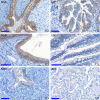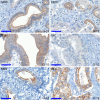Claudin-1, -2, -3, -4, -7, -8, and -10 protein expression in biliary tract cancers
- PMID: 18854598
- PMCID: PMC2628325
- DOI: 10.1369/jhc.2008.952291
Claudin-1, -2, -3, -4, -7, -8, and -10 protein expression in biliary tract cancers
Abstract
Biliary tract cancers are relatively common malignant gastrointestinal tumors in the elderly. Claudins are integral components of tight junctions that play important roles in maintaining epithelial cell polarity, controlling paracellular diffusion, and regulating cell growth and differentiation. The expression profile of claudins has been extensively characterized, but few reports exist on their expression in the normal and neoplastic biliary tract. Our aim was therefore to study claudins by IHC reactions in normal and neoplastic biliary tract samples. We detected that claudin expressions differ in the normal sample groups: the normal gallbladder strongly expressed claudin-2, -3, -4, and -10, but only weak reactions were seen in normal intrahepatic bile ducts. Although each cancer type expressed several claudins with various intensities, only claudin-4 presented especially strong immunoreactions in extrahepatic bile duct cancers and gallbladder carcinomas, whereas claudin-1 and -10 presented in intrahepatic bile duct cancers. Comparing the normal and carcinoma groups, the most significant decrease was detected in the expression of claudin-10. In conclusion, the expression pattern of claudins is different in the various parts of the normal and neoplastic biliary tract; moreover, an unequivocal decrease was detected in the carcinomas compared with their corresponding normal samples. This manuscript contains online supplemental material at http://www.jhc.org. Please visit this article online to view these materials.
Figures





Similar articles
-
Claudin-7 protein differentiates canine cholangiocarcinoma from hepatocellular carcinoma.Histol Histopathol. 2010 Jul;25(7):857-64. doi: 10.14670/HH-25.857. Histol Histopathol. 2010. PMID: 20503174
-
Claudin-4 differentiates biliary tract cancers from hepatocellular carcinomas.Mod Pathol. 2006 Mar;19(3):460-9. doi: 10.1038/modpathol.3800549. Mod Pathol. 2006. PMID: 16439986
-
Differential expression and subcellular localization of claudin-7, -8, -12, -13, and -15 along the mouse intestine.J Histochem Cytochem. 2006 Aug;54(8):933-44. doi: 10.1369/jhc.6A6944.2006. Epub 2006 May 1. J Histochem Cytochem. 2006. PMID: 16651389
-
Claudins in human cancer: a review.Histol Histopathol. 2010 Jan;25(1):83-90. doi: 10.14670/HH-25.83. Histol Histopathol. 2010. PMID: 19924644 Review.
-
Claudins as diagnostic and prognostic markers in gynecological cancer.Histol Histopathol. 2009 Dec;24(12):1607-15. doi: 10.14670/HH-24.1607. Histol Histopathol. 2009. PMID: 19795358 Review.
Cited by
-
E7 oncoprotein from human papillomavirus 16 alters claudins expression and the sealing of epithelial tight junctions.Int J Oncol. 2020 Oct;57(4):905-924. doi: 10.3892/ijo.2020.5105. Epub 2020 Jul 29. Int J Oncol. 2020. PMID: 32945372 Free PMC article.
-
Genotoxic Effect of Salmonella Paratyphi A Infection on Human Primary Gallbladder Cells.mBio. 2020 Sep 22;11(5):e01911-20. doi: 10.1128/mBio.01911-20. mBio. 2020. PMID: 32963006 Free PMC article.
-
The claudin family of proteins in human malignancy: a clinical perspective.Cancer Manag Res. 2013 Nov 8;5:367-75. doi: 10.2147/CMAR.S38294. Cancer Manag Res. 2013. PMID: 24232410 Free PMC article. Review.
-
Bile duct epithelial tight junctions and barrier function.Tissue Barriers. 2013 Oct 1;1(4):e25718. doi: 10.4161/tisb.25718. Epub 2013 Aug 9. Tissue Barriers. 2013. PMID: 24665411 Free PMC article. Review.
-
Claudins and tricellulin in fibrolamellar hepatocellular carcinoma.Virchows Arch. 2011 Jun;458(6):679-88. doi: 10.1007/s00428-011-1077-y. Epub 2011 Apr 19. Virchows Arch. 2011. PMID: 21503766
References
-
- Amasheh S, Meiri N, Gitter AH, Schöneberg T, Mankertz J, Schulzke JD, Fromm M (2002) Claudin-2 expression induces cation-selective channels in tight junctions of epithelial cells. J Cell Sci 115:4969–4976 - PubMed
-
- Anderson JM, Van Itallie CM (1995) Tight junctions and the molecular basis for regulation of paracellular permeability. Am J Physiol 269:G467–475 - PubMed
-
- Bajor J, Bero T, Garamszegi M, Grexa E, Anga B, Szilágyi K (2001) Common bile duct tumor in a young woman with ulcerative colitis. Orv Hetil 142:1231–1234 - PubMed
-
- Balda MS, Matter K (1998) Tight junctions. J Cell Sci 111:541–547 - PubMed
Publication types
MeSH terms
Substances
LinkOut - more resources
Full Text Sources
Other Literature Sources

